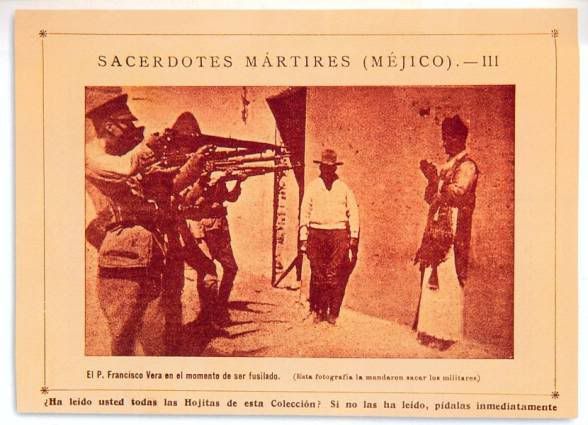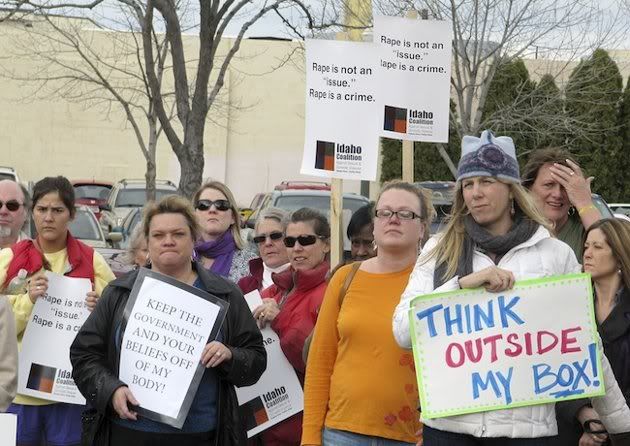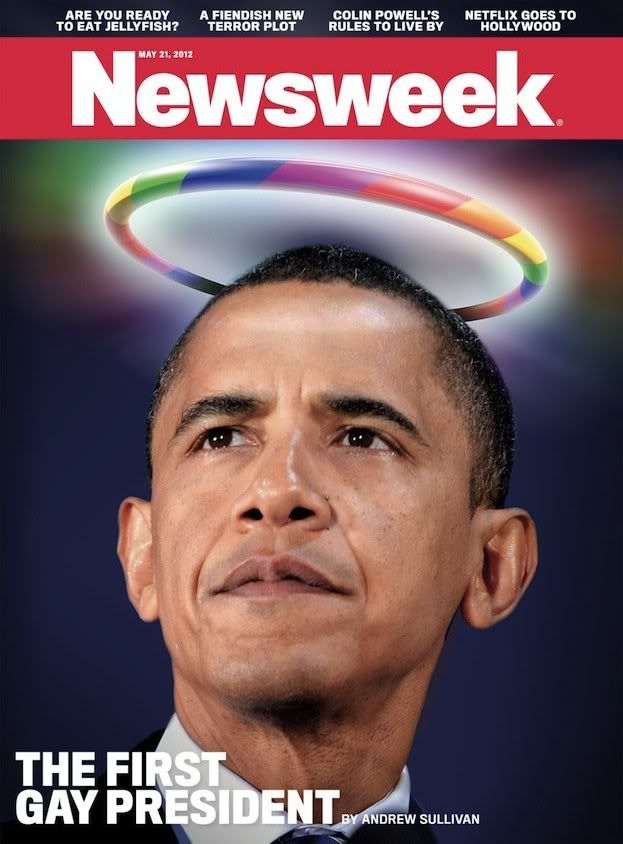
From dayofwrathdiesirae.blogspot.com:
In 1926, a small army of Catholic peasants who took on the name
"Cristeros" (followers of Christ) fought to regain religious freedom in
Mexico. Before they were through, as many as 50,000 men from every
socioeconomic background took up arms against the government.
The
"war" produced many religious refugees, some of whom came to El Paso.
The city welcomed the persecuted, and from this support stemmed the
founding of new seminaries and monasteries, which still exist today.
In
1917, President Plutarco Elías Calles and the former president, General
Álvaro Obregón, weakened the Catholic Church in Mexico by enforcing the
Articles of the 1857 constitution included in the 1917 version. Article
3 called for secular education in the schools, thus outlawing parochial
education. Article 5 closed all seminaries and convents. Article 24
forbade worship outside the physical borders of the church.
Article
27 prohibited religious groups from owning real estate, thus
nationalizing all Church property. Article 130 prohibited priests and
nuns from wearing religious vestments, but more importantly, it took
away from the clergy the rights of voting and speech, prohibiting the
criticism of government officials and comment on public affairs in
religious publications.
The closing of seminaries began during
the Mexican Revolution, leaving nuns and priests with no place to live
or work. The government also ruled that only Mexican born clergy would
be allowed to remain and participate in religious activities in Mexico.
By 1917, hundreds of religious had been expelled from Mexico or had fled
the country.
The Catholic Church did not want to retaliate
violently against the government, so from 1919 to 1926, they obeyed the
laws. However, in 1926, President Calles introduced legislation which
fined priests $250 for wearing religious vestments and imprisoned them
for five years for criticizing the government.
Archbishop of
Mexico, José María Mora y del Río, declared that the Catholic Church
could not accept the government's restraints. On July 31, 1926, the
archbishop suspended all public worship by ordering Mexican clergy to
refrain from administering any of the Church's sacraments.
The
Cristeros felt the only way to fight the government was to take up arms:
they were willing to become martyrs for their freedom of religion. Jean
Meyers, a French expert on this revolution, tells us about Cristeros
attending field masses, dressed in sandals and white garments and armed
with machetes. They knew that soldiers could attack them with machine
guns at any time.
Many priests were martyred while celebrating
mass, either by being shot or beheaded. In a last affirmation of their
faith, the Cristeros would shout, "Viva Cristo Rey!" (Long Live Christ
the King!) just before dying.
Padre Miguel Agustin Pro was one of
the best known of the martyred priests. Pro used elaborate disguises so
that soldiers would not recognize him as a priest. Known for his
indefatigable sense of humor, he visited the faithful often dressed as a
beggar. He administered the sacraments, provided jokes and laughter,
and helped financially those in need. Rich families often received the
sacraments from Padre Pro in his disguise of businessman. Pro and his
brother, Humberto, were arrested for being erroneously linked to a car
bombing which injured ex-president Obregón. The car used in the bombing
was traced back to Humberto Pro, the previous owner.
Calles took
advantage of the opportunity to execute a priest publicly in an attempt
to discourage other priests from participating in politics. He ordered
Pro be shot at the police station and invited reporters to the
execution. Padre Pro carried a small crucifix and his rosary and held
his arms out forming a cross as he was shot. Pope John Paul II beatified
him on September 25, 1988.
Another martyr, San Pedro de Jesus
Maldonado Lucero, served the people's spiritual needs in Chihuahua,
Mexico. Maldonado attended seminary in Mexico in 1914, but the political
conflict forced him to leave. He came to El Paso and received his
ordination on January 25, 1918, from Bishop Anthony J. Schuler at St.
Patrick's Cathedral. Then he returned to Chihuahua to serve the
faithful.
After Calles' anti-Catholic laws were implemented in
1926, Maldonado became a government target for performing religious
ceremonies in private homes. He succeeded in celebrating night masses on
one ranch or another, performing marriages and baptisms and
administering other sacraments. In 1937 during Holy Week, the mayor and
soldiers in Santa Isabel, Chihuahua, arrested him and beat him to death
for defying government bans on hidden religious celebrations.
Maldonado's murderers used riffle butts to bash in his head and dislodge
an eye from its socket.
Like Maldonado, many other priests and
nuns along with ordinary Catholics, Mormons and Episcopalians left the
country and found refuge in border cities in the United States, among
them, El Paso. Patrick Cross writes that by 1929, some 25,000 priests in
approximately 12,000 parishes no longer could minister to the spiritual
needs of Mexican Catholics, over 10 million strong.
In a
personal interview, Dr. Jesus Cuellar, this writer's grandfather,
recalled that at the age of 13, in 1927, he was helping Father Gregorio
Paredes with a secret mass in a house in Guanajuato. After it concluded,
soldiers came looking for a place to feed and water their horses.
In
order to save the priest's life and to keep the Eucharist from
desecration, Cuellar took the Chalice containing the Eucharist and ran
out to hide it in a neighboring house. He and Father Paredes hid in a
basement for three days, waiting for the soldiers to leave.
Persecuted
Mexican Catholics received worldwide sympathy. Boston banned the new
religious regulations calling them "the most brutal tyranny." New York
parishioners crowded Catholic and Protestant churches to offer prayers
for a peaceful solution in Mexico.
El Paso Bishop Reverend
Anthony J. Schuler welcomed Juárez Catholics and even granted priests
permission to perform marriages and baptisms without requiring residency
for the Mexican citizens. Between 1926 and 1929, the number of people
attending services at El Paso Catholic churches doubled. A dramatic
increase in baptisms and marriages of people with Hispanic surnames at
Catholic churches suggested that downtown churches were serving great
numbers of Catholics from Mexico.
Since priests and nuns in
Mexico could no longer teach there, many of them came to El Paso. Three
nuns from the order of Perpetual Adoration and two from the Servants of
the Sacred Heart arrived in El Paso on August 2, 1926. Sacred Heart
Church received the nuns from the Sacred Heart Order with open arms.
Because
there was no Perpetual Adoration order in El Paso, Bishop Schuler
provided the funds for the foundation of such a monastery to train nuns.
Other exiled nuns from Mexico City and Guadalajara soon joined the
first nuns.
Reverend Mother María Concepción del Espíritu Santo
was in charge of the nuns who came from Guadalajara. She found a
suitable location for the monastery in a house at 1401 Magoffin. Along
with money from the diocese, the Catholic community raised funds and
helped pay $7,550 for the property in monthly installments.
Once
El Paso became a diocese in 1926, it was allowed to establish seminaries
and became the home to Franciscans at St. Anthony's Seminary at
Hastings and Crescent in 1935. Before this, the persecuted Franciscan
order of Michoacan, which had not had a seminary since 1910, had lived
in Santa Barbara, Calif., after their departure from Mexico.
The
monasteries and seminaries established at this time succeeded so well
that an additional Perpetual Adoration Monastery in the Lower Valley and
the Roger Bacon Seminary soon followed to house homeless priests and
nuns.
During the religious persecution, some Mexican nationals
who sought and found asylum in El Paso decided to stay here. However,
many returned to Mexico but continued to enroll their children in the
parochial schools here. Perhaps the trend of bringing children to school
across the border began when El Paso met those needs so many years ago.
Even
though Catholicism is no longer openly persecuted in Mexico, the
religious persecution of the 1920s is still felt. The government
prohibits priests from owning property, criticizing government officials
or commenting on public affairs. The state still does not recognize
weddings performed by priests.
In 2000, the Pope canonized 25
priests of the Cristero era, including San Maldonado. The blood of the
thousands of Cristeros and martyrs that flooded the land nourished the
spirits of those left behind; their courageous cry can still be heard in
the hearts of the faithful, "Viva Cristo Rey!"



